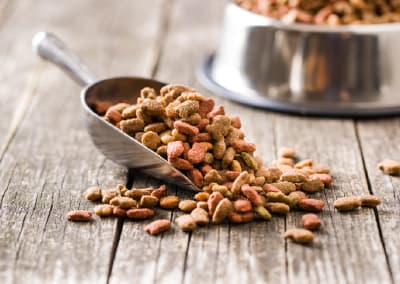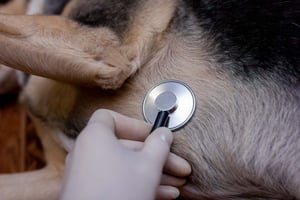Cardiac disease isn’t just about leaky valves or enlarged chambers – it’s a full-body metabolic upheaval. Chronic RAAS activation, inflammatory cytokines and wobbly energy metabolism crank up resting energy needs while suppressing appetite. The result is the dreaded cardiac cachexia, and once that starts survival time plummets (Ineson et al., 2019).
So, what do you as a general practitioner need to know? Whether you’re an aspiring veterinary cardiologist, looking for cardiology CPD, or a nurse with an interest in nutrition – dig in and we’ll explain all! We've split the guide into two parts - an overview of the macro- and micro-nutrient requirements, and then details of stage-specific nutrition, so you can make confident recommendations.
Macronutrients – getting the big stuff right
Fat and energy – fuelling the failing heart
Medium-chain triglycerides (MCTs) skip the usual carnitine shuttle and drop straight into mitochondria for a quick energy fix - diets higher in MCTs may be easier for tired hearts to deal with. Overall calorie density should support resting energy needs plus a bit extra for recovery days when a cough limits walks.
Protein
Dogs lose muscle faster than fat in heart failure. Anything under 6 g/100 kcal puts them on a slippery slope; 8–10 g is safer once Stage C arrives. Senior diets labelled “protein-restricted” are seldom helpful unless kidneys demand it.
Sodium
Sodium is a key nutrient to consider in the dietary management of heart disease, due to its role in fluid balance and its interaction with the renin–angiotensin–aldosterone system (RAAS), which becomes dysregulated in affected dogs. Sodium restriction is regularly recommended in cardiac disease, but is still potentially controversial, especially as a blanket requirement. While mild sodium restriction lowers left-atrial pressure and keeps pulmonary oedema at bay, reducing salt too far may flick RAAS into high gear, undoing your good work (Suematsu et al, 2010). In dogs with chronic heart failure resulting from conditions like MMVD or DCM, limiting sodium intake has demonstrated beneficial outcomes, including a reduction in cardiac size measurements when compared with more moderate sodium consumption (Rush et al., 2000).
Functional nutrients and micronutrients
- Taurine – Although not an essential amino acid in dogs due to their ability to synthesise it, taurine deficiency is associated with heart problems and it is essential for contractility. Low-meat diets and diets containing peas/legumes may have insufficient taurine/methionine - it's worth a switch in dogs presenting with DCM. For other dogs with cardiac disease, supplementation may be beneficial, but more evidence is needed.
- Carnitine – Carnitine is required for energy in heart cells. While not usually considered essential, deficiency (and cardiomyopathy) can occur. Diets for heart disease patients should contain carnitine, or supplement with 50–100 mg/kg three times daily. There are case reports of dramatic improvements in Boxers (Costa & Labuc, 1994).
- EPA + DHA – Omega-3 fatty acids have anti-inflammatory effects and evidence suggests they're helpful in cardiac disease and their use is supported by ACVIM consensus in dogs with stage C heart failure (Keene et al 2019). No definitive dose is known for cardiac disease in dogs.
- Magnesium & Potassium – loop diuretics deplete both magnesium and potassium. Clinicians should check electrolyte levels regularly and consider supplementation if problems are spotted to reduce arrhythmias (Keene et al, 2019).
- Antioxidants (vitamin E, CoQ10) – No good evidence for their use as yet, but some vets supplement.
Stage-specific dietary goals (ACVIM A–D)
Once you've staged the patient's heart disease, their diet can be adjusted to suit:
Stage A – At-risk but normal heart
Stick with everyday good nutrition. Sodium in the 100–140 mg/100 kcal range is perfectly reasonable, and 5–8 g protein/100 kcal maintains lean tissue. Use this calm period to get owners weighing food and practising low-salt treats.
Stage B1 – Soft murmur, no structural change
Nudge sodium down to roughly 80–100 mg/100 kcal and raise protein to at least 6 g/100 kcal (up to 10 g is fine). Start talking about label-reading and the hidden salt bomb that is processed cheese.
Stage B2 – Echo shows enlargement
Time to tighten the belt: 50–80 mg sodium/100 kcal is the sweet spot, still with 6–10 g protein. This is also the moment to add EPA/DHA and to check electrolytes twice a year.
Stage C – First episode of congestive heart failure
Hold sodium at 50–80 mg/100 kcal (occasionally even less), but do not skimp on protein; cachexia risk is now real. Calorie density may need a boost if furosemide blunts appetite.
Stage D – Refractory CHF
Diet becomes bespoke. Some dogs require < 50 mg sodium/100 kcal while others tolerate a little more. Protein often needs a bump to 7–12 g/100 kcal, and highly palatable, MCT-rich foods can help tired hearts use energy efficiently.
Body-condition management – spotting cachexia early
Cachexia rarely announces itself on the scales; a 5 kg Cavalier can drop a third of its epaxial muscle before weight budges. Add a muscle condition score (MCS) line to every heart-check form and flag any downgrade for immediate dietary review. Evidence suggests even a modest uptick in EPA/DHA and protein can slow the slide (Ineson et al., 2019). And forget crash diets: the so-called ‘obesity paradox’ hints that a smidge of padding confers survival benefits once CHF sets in.
Picking the right food – tins, kibble or home-cook?
We all know that commercial cardiac 'prescription' diets are convenient – they have predictable sodium, beefed-up B-vitamins and usually added taurine/carnitine. Just watch out for their protein - a few brands still hover around 4 g/100 kcal which is too low and risks cachexia.
Home-cooked food is an option, but it only works if a suitably qualified canine nutritionist writes the recipe and the owner sticks to it reliably – even small substitutions can have big impacts.
Don’t forget the treats! Train your owners to provide low-sodium treats, like apple and carrot, plain boiled chicken breast, or cooked sweet potato, rather than ham, cheese, and tinned tuna.
The future of cardiac diets
Metabolomics is making some big strides in research, and there’s even some evidence that dogs with MMVD and CHF have dysbiosis, which could become important in treatment. We still need big, prospective outcome studies, but the trajectory is clear – the microbiome has far-reaching effects, and nutrition for clinical disease is about to get far more complex!
Exclusive content just for you!
Download this exclusive content to boost your knowledge and skills.
Take-home message
Food is medicine. From the first innocent murmur to the toughest Stage D case, a carefully tuned diet can delay progression, defend muscle mass and keep canine hearts – and their owners – happier for longer.
P.S Don’t forget to log reading this article on 1CPD – it counts towards vet CPD requirements and vet nurse CPD requirements.

Small Animal Cardiology
ISVPS General Practitioner Certificate (GPCert)
HAU Postgraduate Certificate (PgC)
After graduating from the University of Nottingham in 2016, Jo moved into small animal practice in the midlands, where she grew a passion for client communication and the subjects that most need it - like geriatrics and dermatology. Since 2020 she has worked as a locum vet in the Channel Islands as well as as a content writer in pet health topics.







